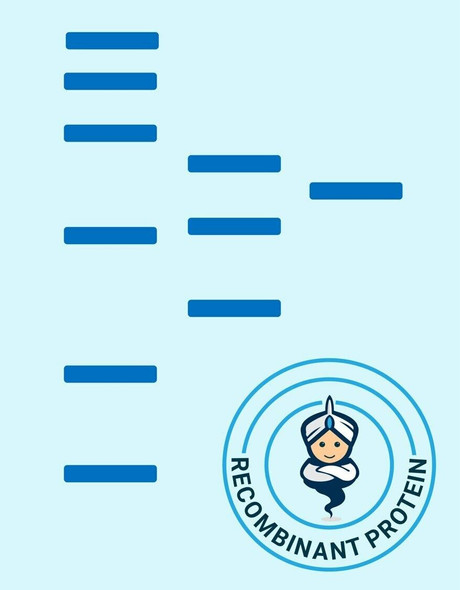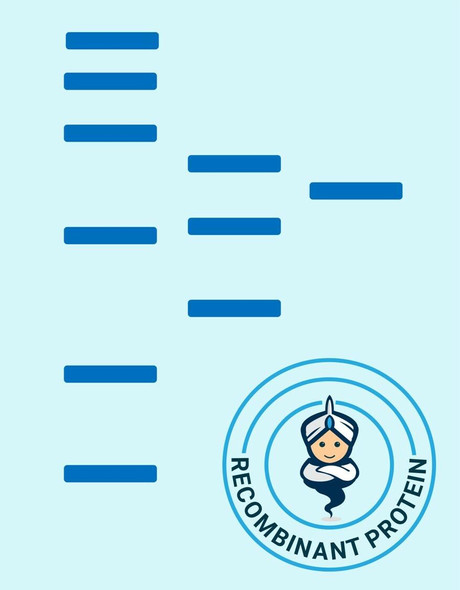Human CCND2 Recombinant Protein (RPPB2999)
- SKU:
- RPPB2999
- Product type:
- Recombinant Protein
- Size:
- 20ug
- Species:
- Human
- Target:
- CCND2
- Synonyms:
- G1/S-specific cyclin-D2
- CCND2
- cyclin D2
- KIAK0002
- Source:
- Escherichia Coli
- Uniprot:
- P30279
Description
| Product Name: | Human CCND2 Recombinant Protein |
| Product Code: | RPPB2999 |
| Size: | 20µg |
| Species: | Human |
| Target: | CCND2 |
| Synonyms: | G1/S-specific cyclin-D2, CCND2, cyclin D2, KIAK0002. |
| Source: | Escherichia Coli |
| Physical Appearance: | Sterile Filtered clear colorless solution. |
| Formulation: | CCND2 protein solution (1mg/ml) containing 20mM Tris-HCl buffer (pH 8.0), 10% glycerol, 2mM DTT and 1M Urea. |
| Stability: | Store at 4°C if entire vial will be used within 2-4 weeks. Store, frozen at -20°C for longer periods of time. For long term storage it is recommended to add a carrier protein (0.1% HSA or BSA).Avoid multiple freeze-thaw cycles. |
| Purity: | Greater than 85% as determined by SDS-PAGE. |
| Amino Acid Sequence: | MGSSHHHHHH SSGLVPRGSH MGSHMELLCH EVDPVRRAVR DRNLLRDDRV LQNLLTIEER YLPQCSYFKC VQKDIQPYMR RMVATWMLEV CEEQKCEEEV FPLAMNYLDR FLAGVPTPKS HLQLLGAVCM FLASKLKETS PLTAEKLCIY TDNSIKPQEL LEWELVVLGK LKWNLAAVTP HDFIEHILRK LPQQREKLSL IRKHAQTFIA LCATDFKFAM YPPSMIATGS VGAAICGLQQ DEEVSSLTCD ALTELLAKIT NTDVDCLKAC QEQIEAVLLN SLQQYRQDQR DGSKSEDELD QASTPTDVRD IDL |
CCND2 is a member of the highly conserved cyclin family, whose members are characterized by a dramatic periodicity in protein abundance through the cell cycle. Cyclins serve as regulators of CDK kinases. Various cyclins demonstrate distinct expression and degradation patterns which contribute to the temporal coordination of each mitotic event. CCND2 forms a complex with and acts as a regulatory subunit of CDK4 or CDK6, whose activity is vital for cell cycle G1/S transition. CCND2 interacts with and is involved in the phosphorylation of tumor suppressor protein Rb. High level expression of the CCND2 protein is observed in ovarian and testicular tumors. In addition, knockout studies of the homologous gene in mouse suggest the vital roles of the CCND2 gene in ovarian granulosa and germ cell proliferation.
CCND2 Human Recombinant produced in E.Coli is a single, non-glycosylated polypeptide chain containing 313 amino acids (1-289 a.a.) and having a molecular mass of 35.6kDa. CCND2 is fused to a 24 amino acid His-tag at N-terminus & purified by proprietary chromatographic techniques.
| UniProt Protein Function: | CCND2: Regulatory component of the cyclin D2-CDK4 (DC) complex that phosphorylates and inhibits members of the retinoblastoma (RB) protein family including RB1 and regulates the cell-cycle during G(1)/S transition. Phosphorylation of RB1 allows dissociation of the transcription factor E2F from the RB/E2F complex and the subsequent transcription of E2F target genes which are responsible for the progression through the G(1) phase. Hypophosphorylates RB1 in early G(1) phase. Cyclin D-CDK4 complexes are major integrators of various mitogenenic and antimitogenic signals. Also substrate for SMAD3, phosphorylating SMAD3 in a cell-cycle-dependent manner and repressing its transcriptional activity. Component of the ternary complex, cyclin D2/CDK4/p27Kip1, required for nuclear translocation and activity of the cyclin D-CDK4 complex. Interacts with either CDK4 or CDK6 protein kinase to form a serine/threonine kinase holoenzyme complex. The cyclin subunit imparts substrate specificity to the complex. Component of the ternary complex cyclin D/CDK4/p27Kip1 required for nuclear translocation and modulation of CDK4-mediated kinase activity. Belongs to the cyclin family. Cyclin D subfamily. |
| UniProt Protein Details: | Protein type:Motility/polarity/chemotaxis; Cell cycle regulation Chromosomal Location of Human Ortholog: 12p13 Cellular Component: chromatin; cyclin-dependent protein kinase holoenzyme complex; cytosol; nuclear membrane; nucleolus; nucleoplasm; nucleus Molecular Function:protein binding; protein kinase binding Biological Process: positive regulation of cyclin-dependent protein kinase activity; positive regulation of protein amino acid phosphorylation Disease: Megalencephaly-polymicrogyria-polydactyly-hydrocephalus Syndrome 3 |
| NCBI Summary: | The protein encoded by this gene belongs to the highly conserved cyclin family, whose members are characterized by a dramatic periodicity in protein abundance through the cell cycle. Cyclins function as regulators of CDK kinases. Different cyclins exhibit distinct expression and degradation patterns which contribute to the temporal coordination of each mitotic event. This cyclin forms a complex with CDK4 or CDK6 and functions as a regulatory subunit of the complex, whose activity is required for cell cycle G1/S transition. This protein has been shown to interact with and be involved in the phosphorylation of tumor suppressor protein Rb. Knockout studies of the homologous gene in mouse suggest the essential roles of this gene in ovarian granulosa and germ cell proliferation. High level expression of this gene was observed in ovarian and testicular tumors. Mutations in this gene are associated with megalencephaly-polymicrogyria-polydactyly-hydrocephalus syndrome 3 (MPPH3). [provided by RefSeq, Sep 2014] |
| UniProt Code: | P30279 |
| NCBI GenInfo Identifier: | 231741 |
| NCBI Gene ID: | 894 |
| NCBI Accession: | P30279.1 |
| UniProt Secondary Accession: | P30279,Q13955, Q5U035, A8K531, |
| UniProt Related Accession: | P30279 |
| Molecular Weight: | 24,461 Da |
| NCBI Full Name: | G1/S-specific cyclin-D2 |
| NCBI Synonym Full Names: | cyclin D2 |
| NCBI Official Symbol: | CCND2 |
| NCBI Official Synonym Symbols: | MPPH3; KIAK0002 |
| NCBI Protein Information: | G1/S-specific cyclin-D2 |
| UniProt Protein Name: | G1/S-specific cyclin-D2 |
| Protein Family: | G1/S-specific cyclin |
| UniProt Gene Name: | CCND2 |
| UniProt Entry Name: | CCND2_HUMAN |










